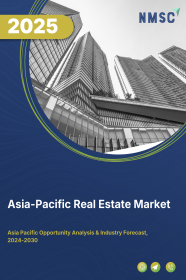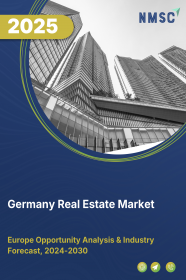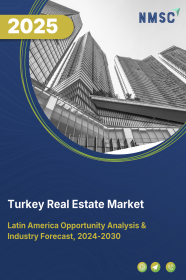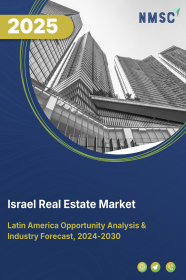
Asia-Pacific Real Estate Market By Property Size (Small (<500 sq. ft.), Medium (500-2000 sq. ft.), and Large (2000+ sq. ft.)), By Property Type (Residential, Commercial, Land and Industrial), By Transaction Type (Buying, Selling, Leasing, Renting, and Real Estate Investment), By Ownership (Owner-Occupied Properties, Rental Properties, Co-ownership) and By Property Value (Individual Buyers, Buisness Entities, Government and Others) – Opportunity Analysis and Industry Forecast, 2024–2030
Industry: Construction & Manufacturing | Publish Date: 03-Feb-2025 | No of Pages: 270 | No. of Tables: 191 | No. of Figures: 136 | Format: PDF | Report Code : CM1206
US Tariff Impact on Asia-Pacific Real Estate Market
Trump Tariffs Are Reshaping Global Business
Market Definition
The Asia Pacific Real Estate Market size was valued at USD 2925.6 Million in 2023, and is predicted to reach USD 4742.1 Million by 2030, at a CAGR of 7.6% from 2024 to 2030.
The real estate industry constitutes a multifaceted market involving the acquisition, development, and management of residential and commercial properties. This expansive sector includes residential real estate, catering to individuals and families, as well as commercial and industrial real estate, focused on business operations and manufacturing. Real estate development involves the creation and enhancement of properties, while real estate investment encompasses acquiring properties for financial gain.
Additionally, a range of professional services, such as those provided by real estate agents and property managers, contributes to the industry's dynamics. Influenced by economic trends, demographic shifts, and regulatory factors, the real estate market is a complex landscape where various stakeholders engage in activities that shape urban environments, support economic growth, and provide investment opportunities.
Rapidly Growing Population Across the Region Drives the Market Expansion
The growing population across the region is driving the demand for housing and infrastructure, thereby boosting the real estate market. As the population continues to rise, the demand for infrastructure, such as housing, offices, and commercial spaces, has been surging.
This presents a significant opportunity for real estate developers and investors. Recognizing these demographic trends enables stakeholders in the real estate industry to make informed decisions about where to invest, the types of properties to develop, and how to tailor offerings to meet the specific needs of the local population.
Growing Integration of Online Property Platform Drives the Market Growth in the Region
An online property platform is a digital marketplace or website designed to streamline and enhance the real estate transaction process. These platforms serve as comprehensive hubs for property seekers and sellers, offering a wide array of property listings with detailed information, including location, size, amenities, and pricing. Users can efficiently search for properties using advanced filters, explore virtual tours, and view high-quality images.
These platforms often provide valuable market insights and trends, empowering users with information about the real estate landscape. Additionally, users can create accounts to save favorite listings, receive property alerts, and track their search history.
Government Policies and Economic Factors Hinder the Market Growth Over the Region
Government policies and regulations, including tax structures and zoning rules, alongside economic uncertainties such as recessions, are the primary factors constraining the growth of the real estate market. These influential elements determine the property values, development opportunities, and investor confidence, thereby making it crucial for real estate professionals to adapt and strategize in accordance with these dynamics, which can significantly impact the market's trajectory.
Rising Smart City and Sustainable Development Projects Across the Region Create Ample Market Opportunities
The growing number of smart cities and sustainable development projects over the region is expected to provide ample opportunities in the real estate market in the coming years. These projects focus on creating eco-friendly, tech-savvy urban environments that enhance the quality of life. As cities face issues of energy efficiency and infrastructure, the real estate sector benefits from constructing environmentally friendly, technologically advanced properties. This trend not only addresses pressing global challenges but also offers a promising future for real estate investors and developers to prosper in a world increasingly focused on sustainability and technology.
China Holds the Dominant Market Share in Asia-Pacific Market
Economic indicators play a pivotal role in steering the dynamics of the real estate industry. The fluctuation of interest rates is a key driver, with lower rates typically boosting demand for real estate due to increased affordability of mortgages. Employment rates serve as a barometer of economic health, influencing consumer confidence and, consequently, the willingness of individuals to invest in property.
Additionally, the overall economic growth, as reflected in the Gross Domestic Product (GDP), is a critical factor shaping the real estate landscape. During periods of economic expansion, rising income levels contribute to greater purchasing power, fostering increased demand for housing and positively impacting the commercial real estate sector.
The rise of remote work, fueled by technological advancements, has altered preferences for property locations, with a growing emphasis on a higher quality of life over proximity to traditional work centers. Smart home features, including automation systems and energy-efficient technologies, have become significant selling points, enhancing both the desirability and value of properties.
Online platforms have transformed the real estate landscape, offering virtual tours, streamlined transactions, and an abundance of information for buyers and sellers. Data analytics empowers real estate professionals with valuable insights into market trends, property values, and investment opportunities.
Vietnam to Witness Substantial Growth in the Asia-Pacific Market
Urbanization and infrastructure development are pivotal factors shaping the real estate market. As urban areas experience population growth, the quality and expansion of infrastructure become critical drivers of property demand and values. Improved transportation networks, including highways and public transit, enhance accessibility, making locations more appealing for real estate development.
The presence of job centers and business districts also plays a significant role, as individuals seek residences close to employment hubs to reduce commute times. Additionally, the concept of mixed-use development, integrating residential, commercial, and recreational spaces, has gained prominence, fostering walkability and a sense of community. In essence, the development of urban infrastructure significantly influences the overall attractiveness and value of real estate in a given area.
The growing population across the region is driving the demand for housing and infrastructure, thereby boosting the real estate market. As the population continues to rise, the demand for infrastructure, such as housing, offices, and commercial spaces, has been surging.
This presents a significant opportunity for real estate developers and investors. Recognizing these demographic trends enables stakeholders in the real estate industry to make informed decisions about where to invest, the types of properties to develop, and how to tailor offerings to meet the specific needs of the local population.
Competitive Landscape
The market players operating in the Asia-Pacific real estate market include Prologis, Inc, Brookfield India Real Estate Trust inc., Tata Housing Development Company Limited., Colliers, Prestige Estates Projects Ltd., Mantri Developers, Mahagun Group, Gaurs Group, Sotheby's International Realty Affiliates LLC, Ajnara, CBRE Group Inc., Keller Williams Reality Inc, China Vanke Co.,Ltd, MITSUBISHI ESTATE CO., LTD and ANCHOR LAND HOLDINGS, INC.
Asia-Pacific Real Estate Market Key Segments
By Property Size
-
Small (<500 sq. ft.)
-
Medium (500-2000 sq. ft.)
-
Large (2000+ sq. ft.)
By Property Type
-
Residential
-
Apartments/Flat
-
Single-Family Homes
-
Multi-Family Homes
-
Condominiums
-
Townhouses
-
Vacation Homes
-
-
Commercial
-
Office Spaces
-
Retail Spaces
-
Co-working Spaces
-
Warehouses
-
-
Land
-
Urban Plots
-
Suburban/Rural Plots
-
-
Industrial
-
Manufacturing Plants
-
Distrubution Centers
-
Data Centers
-
By Transaction Type
-
Buying
-
Selling
-
Leasing
-
Renting
-
Real Estate Investment
-
Direct Property Investment
-
Real Estate Investment Trusts (REITs)
-
By Ownership
-
Owner-Occupied Properties
-
Rental Properties
-
Co-ownership
By Property Value
-
Individual Buyers
-
First-time Homebuyers
-
Repeat Buyers
-
Luxury Buyers
-
Senior/Retirees
-
-
Buisness Entities
-
Startups
-
SMEs
-
Large Corporations
-
-
Government
-
Civic Projects
-
Affordable Housing Initiatives
-
-
Institutional Investors
By Region
-
Asia-Pacific
-
China
-
Japan
-
India
-
South Korea
-
Australia
-
Indonesia
-
Singapore
-
Taiwan
-
Thailand
-
Rest of Asia-Pacific
-
Key Market Players:
-
Prologis, Inc
-
Brookfield India Real Estate Trust inc.
-
Tata Housing Development Company Limited.
-
Colliers
-
Prestige Estates Projects Ltd.
-
Mantri Developers
-
Mahagun Group
-
Gaurs Group
-
Sotheby's International Realty Affiliates LLC
-
Ajnara
-
CBRE Group Inc.
-
Keller Williams Reality Inc
-
China Vanke Co.,Ltd
-
MITSUBISHI ESTATE CO., LTD
-
ANCHOR LAND HOLDINGS, INC.
REPORT SCOPE AND SEGMENTATION:
|
Parameters |
Details |
|
Market Size in 2023 |
USD 2925.6 Million |
|
Revenue Forecast in 2030 |
USD 4742.1 Million |
|
Growth Rate |
CAGR of 7.6% from 2024 to 2030 |
|
Analysis Period |
2023–2030 |
|
Base Year Considered |
2023 |
|
Forecast Period |
2024–2030 |
|
Market Size Estimation |
Million (USD) |
|
Growth Factors |
|
|
Countries Covered |
9 |
|
Companies Profiled |
15 |
|
Market Share |
Available for 10 companies |
|
Customization Scope |
Free customization (equivalent up to 80 working hours of analysts) after purchase. Addition or alteration to country, regional, and segment scope. |
|
Pricing and Purchase Options |
Avail customized purchase options to meet your exact research needs. |

















 Speak to Our Analyst
Speak to Our Analyst

















